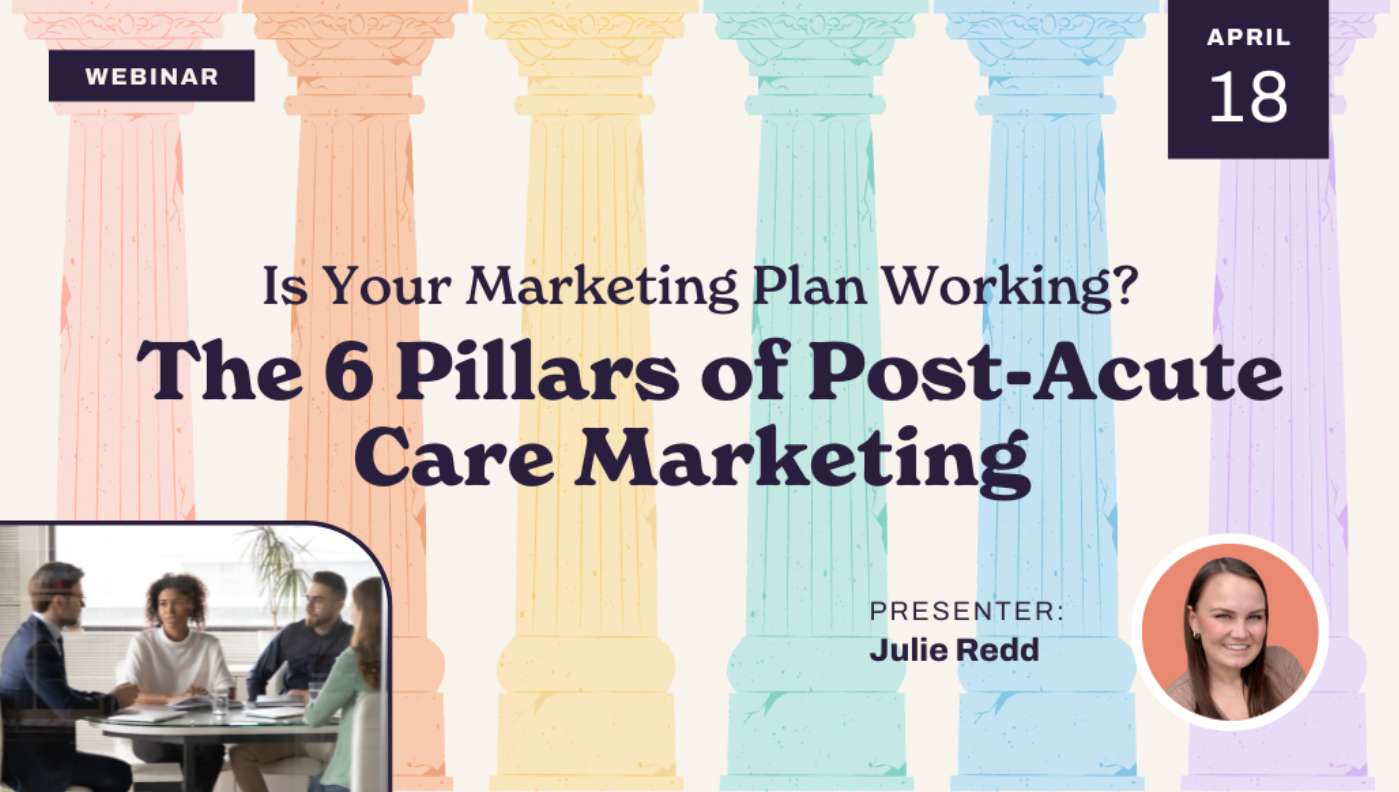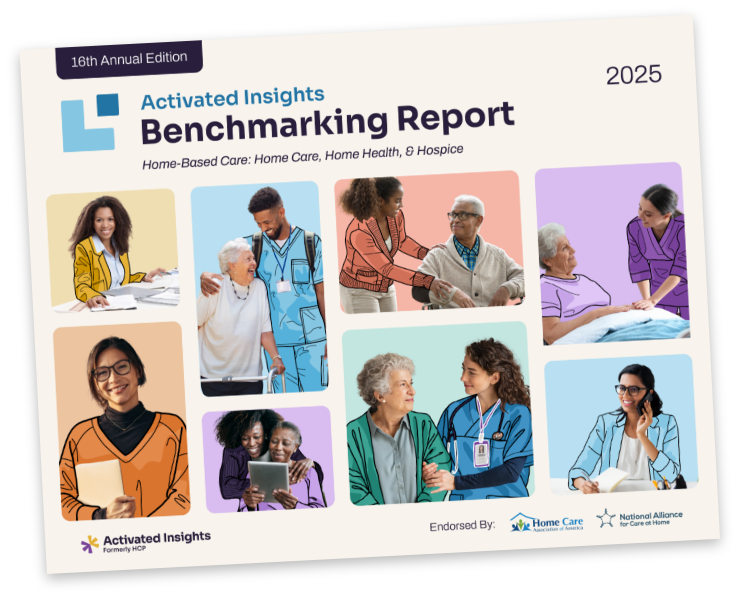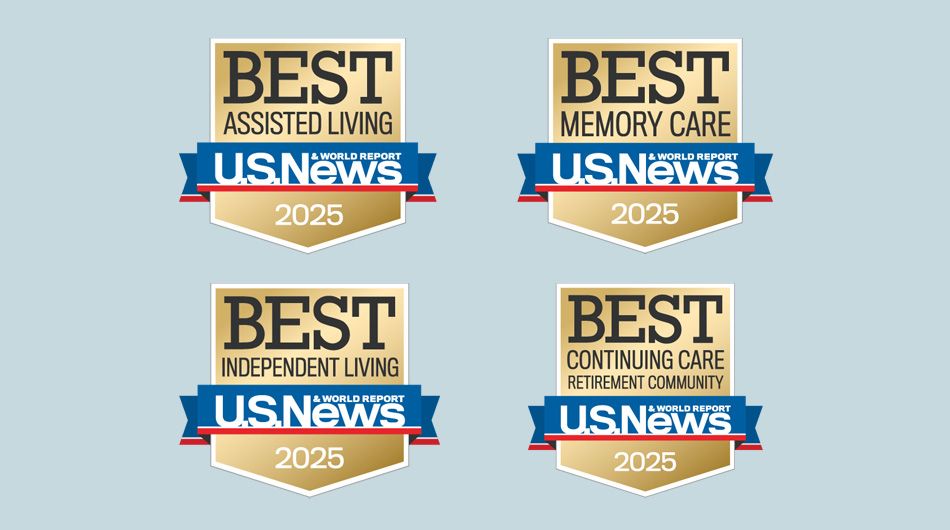Successfully marketing your post-acute care company rests on six proven pillars.
Effectively marketing your post-acute care business—whether home or facility based—is paramount for sustained success. While the strategies and tactics employed may vary between home-based care and senior living, successful marketing plans share six common foundational elements (or pillars).
In this article, we delve into each of these pillars, dissecting their significance and exploring practical approaches to leverage them effectively. From identifying and understanding your target audience to developing a brand identity that resonates with them to making sure they know you exist; these pillars encapsulate the essence of successful marketing in today’s post-acute environment.
- Branding
- Promotion
- Social Media
- Event Marketing/Networking
- SEO
- Reputation Management
In this article we’ll dissect each of these pillars and how to put each of them to work for your home-based care or senior living business.
Branding for Post-Acute Care: Creating an Identity Customers Can Connect With
Your brand is the cornerstone of your business’s identity, embodying its values, mission, and differentiator.
As a post-acute care provider, your brand serves as a powerful tool to differentiate yourself in a very crowded field. A strong brand not only helps your business stand out, it also cultivates trust and loyalty among customers. By consistently delivering on your brand promise and establishing a distinct personality, you can forge long-term emotional connections with your audience.
The Payoff of Building Equity in Your Brand
Solid branding influences consumer perceptions and shapes their purchasing decisions. A well-crafted brand identity communicates credibility and professionalism, instilling confidence in potential customers. Positive satisfaction scores, industry awards, and a stellar online reputation all support the strength of your brand and its ability to attract and retain customers and employees (yes, your brand matters to new recruits as well!).
In essence, branding acts as a shortcut for consumers and staff searching for trustworthy brands that align with their values.
Furthermore, a strong brand has the power to command premium pricing. When consumers develop a strong affinity towards a brand, they are often willing to pay a premium for its offerings and convince others to do the same. Starbucks is a prime example of this. Starbucks loyalists happily drop $6-$8 on a cup of coffee due to the influence of the brand and what it stands for.
By investing in branding initiatives that resonate with your target audience and consistently delivering exceptional experiences, your home care or senior living business can enhance its market positioning and establish a stronger bottom line.
5 Elements of a Strong Brand
The following five elements are considered essential for creating a strong brand:
- Brand Identity: Your brand identity should clearly convey what your brand stands for, its values, mission, and unique selling points. Writing a mission statement can help you develop and articulate these core components. Consistent alignment with your brand identity in all forms of external communication, as well as in your daily operations, is crucial for building awareness, retention, and credibility of your brand identity.
- Brand Personality: A brand’s personality refers to its human characteristics and traits. It includes your brand’s tone of voice, values, and the emotions you aim to evoke in your audience. A well-defined brand personality helps customers connect with your brand on a deeper level.
- Brand Positioning: Positioning involves identifying and communicating what makes your brand unique, valuable, and relevant to your customers. Your brand positioning helps people understand why they should choose you over everyone else offering the same product or service.
- Brand Promise: Your brand promise is the commitment you make to your customers about what they can expect from your services. It encapsulates the benefits and experiences you guarantee to deliver consistently. Keeping your brand promise builds credibility and loyalty among customers.
- Brand Experience: From their first impression to their last day of care, every interaction a customer has with your brand impacts their experience. Creating positive and memorable brand experiences at every touchpoint helps in building lasting relationships with customers.
Each of these components plays a crucial role in shaping how your brand is perceived and remembered by your target audience. Consistency and authenticity across these elements are key to building a strong and cohesive brand.
Creating a mission statement not only helps you develop a brand that accurately reflects your company’s values, but also ensures your messaging and tactics give people the
Related: Creating a Brand for You Home Care Business: An Important Step in the Marketing Process
Promotion for Post-Acute Care Businesses: Spreading the Word
Regardless of whether you operate in a home setting or a community, promotion serves as a vital component of your marketing strategy in post-acute care. Effective promotion raises awareness, drives sales, and supports growth. When executed well, promotion cuts through the clutter and captures the attention of your audience. Poorly executed promotion results in your message blending in with the rest of the noise.
3 Tips for Tuning into the Right Channels
By showcasing your care services through various promotional channels such as advertising, sales promotions, public relations, social media, and digital marketing, you can amplify your visibility and reach a wider audience. Here are three things to keep in mind as you chart your course across the channels:
- Know your audience: Finding the right channels to promote your brand comes down to a simple strategy: put your message where your audience is actually going to receive it. This obviously requires research and a good understanding of your audience’s preferences and behaviors. Uncovering essentials like where your audience lives, where they hang out (in person and online), and how they prefer to get their information can be the difference between hitting the bullseye and missing the target entirely.
- Consider your goals and budget: Define your promotional goals, whether it’s increasing brand awareness, driving website traffic, generating leads, or boosting sales. Evaluate the strengths and limitations of different promotional channels in relation to your goals and budget. Consider factors such as cost-effectiveness, reach, targeting options, and potential ROI when selecting the right channels for your business.
- Test and analyze: Great marketers don’t strike gold by possessing some innate ability of knowing exactly where to mine. They constantly test, analyze, and base their next decisions on the results. You don’t have to be a seasoned marketing director to follow this recipe for success. Experiment with multiple promotional channels to identify which ones yield the best results for your business. Allocate a portion of your budget to test different channels, messaging, and strategies, and track key performance metrics such as reach, engagement, conversion rates, and cost per acquisition (CPA). Analyze the data collected from your promotional campaigns to refine your approach and optimize your marketing efforts over time.
Creating the Right Message
At its core, promotion is just communication. It’s a way for you to disseminate your value proposition and key messages to consumers. Getting the message right is pivotal. If it doesn’t resonate with your audience, you’ve wasted your time and money. Knowing your audience is key to crafting the right message (noticing a trend with knowledge of your audience?). From appealing their desires to solving their problems to speaking their language (natively and conversationally), crafting the right message can establish meaningful connections, convert prospects into customers, and build lasting brand affinity.
Putting Your Money where Your Mouth Is
Strategically allocating resources to the right promotional activities yields the highest return on investment. And the right activities don’t just equate to picking the right channel. Allocating additional resources when customers are looking to spend (a.k.a. seasonality) can be more effective than evenly spreading your promotional budget out over 12 months.
Tracking performance is essential for success. Study what channels perform best, what messages perform best, what time of year works best, what time of day works best, and beyond. Identifying your promotion sweet spots will help you know where to prioritize your marketing spend and get your message in front of the right people at the right time.
Social Media for Post-Acute Care: Sharing for Caring
Social media platforms offer a dynamic and interactive space where your post-acute care business has access to a vast and diverse audience, enabling you to amplify your reach and extend your influence beyond traditional marketing channels.
In addition to staying top of mind by staying in constant contact with current and potential customers, social media also offers invaluable insights into consumer preferences, behaviors, and trends. Social media is a treasure trove of audience intel, allowing you to gather real-time feedback, conduct market research, and refine your strategies as necessary.
Choosing the Right Platform
There are several factors to consider before building your social media empire.
- Which platform does your audience use? The various social media platforms cater to distinct demographics and interests, so conducting thorough research to identify where your audience spends their time online is essential.
- What type of content will you share? Different social media platforms cater to different content types. For example, if photos are your content of choice, Pinterest might be best. However, if you’re thinking of publishing longer videos, YouTube could be your best bet. Photos and videos are exceptional for eliciting emotional responses, making them wise choices in an industry like post-acute care where people are at the heart of what you do.
- What are your goals? Are you looking to generate leads? Do you want to increase brand awareness? Do you want to drive people to your website? Whatever your goals, you’ll want to align them with the strengths of the platform(s) you choose.
- Where are your competitors? Track down your competitors to see where they’re most active. Look for things like how they communicate, how often they post, and how much engagement they’re getting. You don’t have to be a social media expert to see what’s working for them and what’s not. Don’t be afraid to copy what’s working and look for any gaps in their approach that you can fill.
- What is your budget? Social media—some channels more than others—is rapidly becoming a pay to play environment. Organic reach has been throttled by some platforms to encourage (or force) businesses to buy ads or boost posts to reach users. The good news is that you can be successful on a limited budget, but you’ll want to research the platforms you’re leaning towards to see how much budget you’ll need to allocate to reach customers.
Don’t Chase the Squirrel
Countless businesses (including highly successful ones) have fallen into this trap. A new social media platform emerges, and companies race to plant their flag in its fresh soil without understanding how to use it effectively—or whether they should be using it at all. While it may seem like it’s always important to be first, it’s more important to be effective. Give the platform some time to develop so you can see how people engage with it and how companies are succeeding with it.
Also, if you’re chasing every new platform that pops up, you’re pulling your attention away from the ones you’re currently on. Focus on building a thriving profile on one platform before setting out to conquer another. It’s better to be great on one than mediocre (or worse) on five.
Event Marketing for Post Acute Care: Mingling with the Masses
Event marketing can be a powerful tool for engaging with your community, driving foot traffic, and fostering meaningful connections.
The first step in using event marketing effectively is to identify opportunities that align with your business’s goals and target audience. This could include hosting or participating in local events such as street fairs, festivals, charity fundraisers, or community gatherings. By selecting events that attract your ideal customer demographic and align with your brand values, you can ensure maximum relevance and impact.
Once you’ve chosen the right events to participate in, you’ll want to create a compelling presence that captures attendees’ attention and leaves a lasting impression. This could involve setting up an eye-catching booth or display, offering interactive activities, or providing giveaways to attendees.
Leveraging social media and other digital channels to promote your participation in the event can generate buzz and boost attendance Encourage attendees to share their experiences on social media using event-specific hashtags or geotags to amplify your reach and engagement.
Finally, be sure to follow up with and nurture people who engaged with you at the event. Collect contact information from attendees through sign-up forms, business cards, prize drawings, or digital interactions, and immediately follow up to nurture those leads.
By leveraging event marketing as a strategic tool to engage with your community and build meaningful relationships, local businesses can drive brand awareness, customer loyalty, and ultimately, business growth.
Event Marketing Ideas for Post-Acute Care Providers
In need of a little help to stir up those creative juices? Here are some examples of event marketing activities used successfully by post-acute care businesses:
- Senior Health and Wellness Workshops: Host educational workshops and seminars focused on senior health and wellness topics such as nutrition, exercise, mental health, and disease prevention. Invite healthcare professionals, nutritionists, and fitness experts to speak at the events and provide valuable insights and tips. These workshops educate attendees, position your company as a trusted authority in the field, and build relationships with potential clients and their families.
- Community Open Houses and Facility Tours: Organize open houses and facility tours to give seniors and their families the opportunity to explore your senior care facility, meet the staff, and learn about the services offered. Provide guided tours, presentations, and Q&A sessions to address any questions or concerns attendees may have. Offer refreshments, giveaways, and promotional materials to create a welcoming and engaging atmosphere.
- Senior Social Events and Activities: Arrange social events and activities specifically designed for seniors to promote socialization, engagement, and a sense of community. Examples include senior fitness classes, art workshops, gardening clubs, game nights, or themed parties. You can also partner with local senior centers, retirement communities, or community organizations to co-host these events and expand your reach.

15th Annual Edition of the Activated Insights Benchmarking Report
The industry wants to hear from you! Add your voice to years of historical industry data for our 15th Annual Edition of the Activated Insights Benchmarking Report. Complete the survey by February 29,2024 for a FREE digital copy of the 2024 Report.
SEO for Post-Acute Marketing: Get Found Where Everyone’s Looking
Search Engine Optimization (SEO) enhances a website’s visibility and rankings on search engine results pages (SERPs). At its core, SEO involves optimizing various elements of your website, including its content, structure, and performance, to appeal to the algorithms used by Google, Bing, Yahoo, and other search engines.
SEO encompasses a range of tactics aimed at increasing online visibility, driving targeted traffic to the site, attracting qualified leads, and ultimately, achieving your digital marketing objectives.
Organic vs Paid
In the simplest terms, organic and paid SEO are differentiated by whether you pay for your results, or you achieve them free (unless you’re outsourcing).
Organic SEO involves optimizing a website’s content, structure, and technical aspects to naturally rank higher in search engine results for relevant keywords and phrases. Conversely, paid search, a.k.a. search engine marketing (SEM) or pay-per-click (PPC) advertising, involves paying for sponsored placements or ads within search engine results.
Organic success is generally achieved over a longer period of time whereas SEM can yield benefits faster. Both organic and paid strategies have their advantages and are often used in conjunction to maximize a website’s visibility and traffic.
10 Tips for Boosting Organic SEO
- Conduct thorough keyword research to identify relevant terms and phrases that your target audience is searching for. Use tools like Google Keyword Planner, SEMrush, or Ahrefs to find high-volume and low-competition keywords.
- Optimize your website’s on-page elements, including title tags, meta descriptions, headings, and content, to align with your target keywords.
- Create high-quality, informative, and engaging content that addresses the needs and interests of your target audience. Regularly publish new content such as blog posts, articles, videos, infographics, or guides to attract organic traffic and establish authority in your niche.
- Create original content. Due to the historical prevalence of people scraping content from other websites and posting it as their own, Google has enforced a no-nonsense approach to duplicate content. Ensure your web pages and blog articles are your own or get banished to the uncharted nether regions beyond page one of the SERPS.
- Ensure your website is mobile-friendly and responsive, as Google prioritizes mobile-friendly websites in its search rankings. Optimize page loading speed and user experience on mobile devices to provide a seamless browsing experience.
- Optimize your website’s technical aspects, including site structure, URL structure, internal linking, XML sitemap, and schema markup. Fix crawl errors, mend broken links, improve site speed, and ensure proper indexing of your website’s pages by search engines.
- Earn “high-quality” backlinks from reputable websites and authority sources within your industry. Focus on natural link building through content promotion, guest blogging, influencer outreach, and participation in relevant online communities. Never use link farms.
- Share your content on social media platforms to increase visibility, engagement, and potential backlinks. Social signals are considered by search engines as indicators of content relevance and authority.
- Prioritize user experience by making your website easy to navigate, intuitive, and visually appealing. Improve page layout, readability, accessibility, and load times to enhance user satisfaction and reduce bounce rates.
- Regularly monitor your website’s performance using tools like Google Analytics and Google Search Console. Maintaining good SEO performance is an ongoing effort, not something you set and forget. Analyze key metrics such as organic traffic, keyword rankings, and conversion rates to identify areas for improvement and optimization.
10 Tips for Improving SEM/PPC
- Conduct thorough keyword research to identify relevant terms and phrases that potential customers are searching for. Use tools like Google Keyword Planner or SEMrush to discover high-volume and low-competition keywords.
- Write compelling ad copy that is relevant to the keywords you’re targeting. Highlight unique selling points or promotions to entice users to visit your website and include a clear call-to-action (CTA) to encourage clicks.
- Ensure that your landing pages are optimized for the keywords and ad copy used in your campaigns. The landing page should provide a seamless user experience, with relevant content, clear navigation, and a strong CTA to encourage conversions.
- Take advantage of ad extensions such as sitelinks, callouts, and structured snippets to provide additional information to users and improve ad visibility. Ad extensions can help increase click-through rates and improve ad performance.
- Continuously test different ad variations to identify which messaging, imagery, and CTAs resonate best with your target audience. A/B testing can help you optimize your ads for better performance over time.
- Regularly review and adjust your keyword bids to ensure that you’re maximizing your budget and achieving the best possible ROI. Bid management tools and automated bidding strategies can help streamline this process.
- Focus on improving your Quality Score, which is a metric used by search engines to evaluate the relevance and quality of your ads and landing pages. Higher Quality Scores can lead to lower costs per click and better ad placements.
- Organize your ad campaigns and ad groups in a logical manner, with each campaign targeting a specific product, service, or audience segment. This allows for better control over budget allocation and more targeted messaging.
- Implement conversion tracking and use analytics tools like Google Analytics to monitor the performance of your paid SEO campaigns. Track key metrics such as click-through rates, conversion rates, and return on ad spend (ROAS) to identify areas for improvement and optimization.
- Regularly monitor and optimize your campaigns based on performance data and changes in market conditions. Stay up to date with industry trends and algorithm updates to adapt your strategies accordingly and stay competitive.
Local SEO: Claiming Your Territory
Local SEO is so important to brick-and-mortar businesses, such as a home-based care provider or a skilled nursing facility, we’re dedicating a section to it. Unlike traditional SEO, which targets a broader audience, local SEO focuses on optimizing your website to appear prominently in local search results.
By optimizing your online presence for local search queries, you can ensure you show up in relevant local searches, such as “senior care facilities me” or “hospice services in Tampa.” This increased visibility puts you in front of customers actively searching for your services.
But how do you succeed with local SEO as a post-acute care business? Here are a few tips for success:
- Claim and optimize your Google My Business (GMB) listing: Claim your Google My Business listing and ensure that all information, including business name, address, phone number (NAP), website URL, and business hours, is accurate and current. Add relevant categories, photos, and videos to optimize your listing.
- Optimize for local citations: Ensure your business is listed accurately and consistently in online directories, citation sites, and local business listings. Optimize your NAP information, and include relevant details such as business categories, descriptions, and services offered. Software is available to help you locate and correct (if needed) all your local citations.
- Create localized, optimized content: Create content that addresses the needs, interests, and concerns of your target audience in specific geographic areas. Write blog posts, articles, or guides focusing on local events, news, and attractions to attract local visitors. Incorporate local keywords into your web pages, meta tags, and headings to target local search queries.
- Build local links: Earn local backlinks from reputable websites, directories, and local businesses in your area. Participate in local events, sponsorships, or partnerships to build relationships and acquire relevant backlinks.
- Local schema markup: Implement local schema markup on your website to provide search engines with additional context about your business, such as your address, phone number, business hours, and reviews. This helps search engines understand and display your business information more accurately in local search results.
- Generate online reviews and ratings: Encourage satisfied customers to leave positive reviews and ratings on your Google My Business listing and other review sites. Respond promptly to both positive and negative reviews to show engagement, address customer concerns, and improve your reputation.
Speaking of generating online reviews and ratings, reputation management is another pillar of marketing success in home-based care or senior living. Continue reading to discover why, and how to master it.
Reputation Management for Post-Acute Marketing: Uncovering the Truth and Using It to Your Advantage
In today’s digital landscape where online reviews, social media conversations, and news articles directly impact your reputation and profitability, your brand’s reputation may be its most valuable asset. Reputation management is a means to influence, monitor, and maintain a strong perception of your brand in the eyes of the public.
Effective reputation management requires a proactive approach to building and strengthening your company’s reputation. This entails:
- Delivering exceptional customer experiences
- Surveying customers and employees
- Identifying and resolving small problems before they grow
- Locating online commentary and reviews about your business
- Responding to feedback (good and bad)
According to a survey conducted by BrightLocal, 84% of consumers trust online reviews as much as personal recommendations. This statistic underscores the importance of your reputation. In an industry where people are choosing a company to care for their wellbeing, or the wellbeing of a loved one, trust has a major influence on final decision.
Creating a Review Campaign: How to Start Collecting Feedback
While some people will seek out a way to reward your exceptional care with a glowing review, most need a bit of encouragement. Creating a review campaign will help you capture more endorsements of your brand, establishing trust and strengthening your reputation on the way to business growth. Here are a few pointers for putting your campaign together:
- Set Clear Goals: Whether it’s increasing the number of positive reviews, improving your business’s reputation, or boosting sales, having clear goals will guide your campaign strategy.
- Research Review Platforms: Determine which review platforms are most relevant to your business and where your target audience is most active. Common platforms include Google My Business, Yelp, Facebook, and industry-specific review sites like Caring.com.
- Ask for Reviews: Craft persuasive messaging that encourages your customers to leave reviews. Whenever asking for something, it’s always helpful to provide a reason for your request. So, emphasize the importance of their feedback and how it helps your business improve.
- Time the Request Strategically: Ask for feedback when your customers are most likely to be satisfied.
- Utilize Multiple Channels: Maximize your campaign’s reach by using a mix of channels, including email, social media, direct mailers, signage, receipts, or follow-up calls.
- Offer Incentives (Carefully): Consider offering incentives to encourage customers to leave reviews. However, be cautious with incentivizing reviews to ensure compliance with review platform guidelines. Focus on rewarding participation rather than the content of the review itself.
- Make it Easy: Provide a simple, glitch-free process for leaving reviews. If it’s not easy or intuitive to leave a review, people won’t stick around long to figure things out—and it’s a challenge to get them back a second time. If your process is more cumbersome and you can’t fix it, at least provide excellent instructions to help.
- Promote Positive Reviews: In addition to adding credibility to your marketing claims, positive reviews seed the soil from which comments can grow. Some people feel more comfortable leaving reviews if they see that others have already commented, so put those positive reviews front and center.
- Monitor, Measure and Pivot as Necessary: Continuously evaluate the effectiveness of your review campaign and make adjustments as needed. Monitor key metrics such as the number of reviews generated, sentiment analysis, and any changes in customer engagement or sales.
3 ‘Be’s’ to Better Reputation Management
Ongoing success in reputation management boils down to three key components:
Be proactive. Proactive engagement involves actively monitoring online conversations, soliciting feedback, and consistently delivering exceptional experiences to build a positive reputation preemptively.
Be transparent. Transparency entails openly addressing any issues or concerns that arise, communicating honestly with stakeholders, and being transparent about company policies, practices, and values.
Be responsive. Responsiveness is crucial for addressing negative feedback or incidents promptly, demonstrating empathy, and taking concrete steps to resolve issues and restore trust. While a negative review can be damaging, ignoring it and hoping nobody will read it is worse. Responding to comments goes a long way towards restoring trust and faith in your brand, as well as shedding light on your attempts to satisfy an unsatisfiable individual.
Reputation management is a full-time job. This is why many companies use a third-party specialist or software to lighten the load. Investing in reputation management is not just a prudent business strategy but a critical imperative for long-term growth and sustainability.
Wrapping Things Up
The six pillars of success in post-acute care marketing serve as guiding principles to help you build effective plans and strategies to achieve your goals. By following them, you’ll build a strong brand that continues to attract and delight both customers and employees.
Do you use these pillars in your marketing plans? If so, we’d love to hear your success stories. Drop a comment below.
Related: 15 Home Care Marketing Ideas Any Agency Can Succeed With
Related Posts












